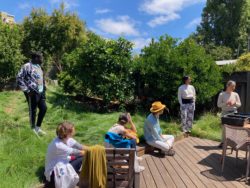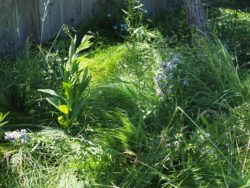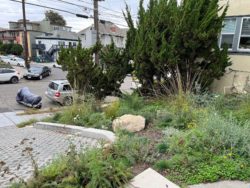Lot size: 600 sq. ft. front and 1,770 sq. ft. back gardens, 95% native
Garden Age: Garden was installed in stages, beginning in 2021
Years on the Bringing Back the Natives Garden Tour: New this year!
Note: This garden is accessed via a steep driveway, and should not be visited by anyone who is not completely stable on their feet.
Showcase Feature
If you’re interested in replacing your lawn with an attractive, low-maintenance, and low-water-consuming native substitute, or need ideas for gardening on a steep slope, this is garden will be of interest to you.
When the Lewis/Rudraraju family bought their Lake Merritt-adjacent property the perimeter of the back garden was lined with a pleasing array of mature fruit trees (persimmon, pomegranate, apple, lemon, mandarin, and pomello), but the long-neglected lawn didn’t meet their desire for a native, biodiversity-enhancing garden their children could romp around in and establish a connection to nature through. Enter the landscape architecture firm Field Collective, which designed the 1,200 square foot meadow of native bunch grasses and flowers that now surrounds the fruit trees. The “Mow-Free” sod “lawn” does well in full sun to dappled shade, tolerates light foot traffic—and is punctuated with cheerful lavender aster, pink farewell to spring, yellow goldenrod, and creamy yarrow, which provide seasonal interest. To keep a path clear, some areas get mowed 3-4 times a year and then the whole meadow gets mowed once a year for maintenance.
 The steep front yard was a mass of weeds, contained by a series of failing concrete retaining walls. The goal was an attractive, low water-consuming native plant garden that would stabilize the slope. When selecting the plants textures, colors, massing, and seasonality were all considered, with larger shrubs placed at the back and smaller, more finely detailed plants located along the edges, where there is more visibility. Low-growing, spreading plants were positioned in steeper areas to help prevent erosion. Napa basalt boulders provide visual interest. The new front garden, planted in 2022, includes black sage, Idaho fescue, common woolly sunflower, Pacific mist manzanita, salvia ‘Bees Bliss’, deer grass, big saltbush, St. Catherine’s lace, and coyote mint.
The steep front yard was a mass of weeds, contained by a series of failing concrete retaining walls. The goal was an attractive, low water-consuming native plant garden that would stabilize the slope. When selecting the plants textures, colors, massing, and seasonality were all considered, with larger shrubs placed at the back and smaller, more finely detailed plants located along the edges, where there is more visibility. Low-growing, spreading plants were positioned in steeper areas to help prevent erosion. Napa basalt boulders provide visual interest. The new front garden, planted in 2022, includes black sage, Idaho fescue, common woolly sunflower, Pacific mist manzanita, salvia ‘Bees Bliss’, deer grass, big saltbush, St. Catherine’s lace, and coyote mint.
Parking at this garden will be tight; be prepared to park some distance away and walk in.
Other Garden Attractions
• The front garden is watered with a drip irrigation system; the back is on a sprinkler system.
Gardening for Wildlife
This urban meadow is a haven for local biodiversity, and is awash with insects, from tiny bugs only visible when the sun catches them, to butterflies and bees.

OLYMPUS DIGITAL CAMERA
Garden Talks
11:00 “The Meadow-making Process” by Alexandra Harker
Keystone species in this garden(watch this talk by Doug Tallamy!)
Keystone species—our own, local ecological powerhouse plants— in this garden include manzanita, buckwheats, sages, aster and goldenrod.
Parking
Parking at this garden will be tight; be prepared to park some distance away and walk in.
















